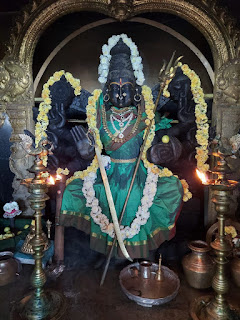मूलाधाराम्बुजा-रूढा (514)
Mūlādhārambujā-rūḍhāa
Yogini who presides over this chakra is Sākinī, who is described in the next seven nāma-s till nāma 520. This cakra is situated at the perineum area and has four lotus petals that are red in colour. Each petal is inscribed with four consonants with bindu-s. The pericarp of this cakra is square in shape with eight spears protruding outwardly. Inside this pericarp, the bīja of this cakra laṁ (लं) is placed. There is a red inverted triangle within the pericarp that flashes like lightning. Inside this triangle, the powerful klīṁ bīja (क्लीं), also known as kāma bīja, is placed. The bīja for earth is laṁ and this is appropriate because mūlādhāra cakra is the lowest cakra which is also known as the base cakra. Inside this triangle, there is a Liṅga (one of the prominent forms of Śiva). Kuṇḍalinī energy in the form of a snake coiled around this Liṅga three and half times. There is a hole which is called dvāra in Sanskrit in this cakra, through which Kuṇḍalinī ascends and descends. Under normal circumstances, the mouth of this hole is blocked by the head of this snake. This is the most important cakra as it holds the life energy in the form of Kuṇḍalinī here. Lalitāmbikā dwells in this cakra in the form of Kuṇḍalinī, Her subtlest form.
पञ्च-वक्त्रा (515)
Pañca-vaktrā
Sākinī is five faced, hence described in this Sahasranāma as the fifth cakra. Each of these faces represents five elements like ākāś, air, etc.
अस्थि-संस्थिता (516)
Asthi-saṁsthitā
Sākinī presides over bones, the fifth layer from the skin. This is also one of the reasons for taking up this cakra as the fifth in this Sahasranāma.
अङकुशादि-प्रहरणा (517)
Aṅkuśādi-praharaṇā
Sākinī has weapons like elephant-hook. She is said to have four arms and apart from elephant-hook, she also carries lotus, book and cin mudra (mudra of knowledge or jñāna mudra).
वरदादि-निषेविता (518)
Varadādi-niṣevitā
Sākinī is surrounded by her assistants like Varadā ,Śrī (possibly indicating prosperity as Śrī means Lakṣmī), Śandā and Sarasvatī (goddess of knowledge).
मुद्गौदनासक्त-चित्ता (519)
Mudgaudanāsakta-cittā
Sākinī is fond of food of made of green gram. The combination of mudgaudannā is rice mixed with green gram, jaggary, coconut, jīraka, ghee and milk.
साकिन्यम्बा-स्वरुपिणी (520)
Sākinyambā-svarupiṇī
The presiding deity of the mūlādhāra cakra is in the form of Sākinī who has been described in these seven nāma-s.
आज्ञा-चक्राब्ज निलया (521)
Ājñā-cakrābja nilayā
The next seven nāma-s discuss about the presiding deity of ājñā cakra, Hākinī. Ājñā cakra is considered as the most important cakra and is located between the two eye brows. This cakra has two lotus petals and bīja-s haṁ (हं) and kṣaṁ (क्षं) are inscribed in those white petals.
शुक्ल-वर्णा (522)
Śukla-varṇā
Hākinī has fair complexion. This could be due to the purity of ājñā cakra.
षडानना (523)
ṣaḍānanā
Hākinī has six faces and hence described as the sixth cakra in this Sahasranāma.
मज्जा-संस्था (524)
Majjā-saṁsthā
Hākinī presides over bone marrow, the sixth layer from the skin hence ājñā cakra is discussed as the sixth cakra in this Sahasranāma.
हम्सवती-मुख्य शक्ति-समन्विता (525)
Hamsavatī-mukhya śakti-samanvitā
Hākinī is attended by two of her assistants. They are Haṁsavati and Kṣamāvati, representing the two bīja-s haṁ (हं) and kṣaṁ (क्षं). In all these cakra-s, the names of the assistants to the yogini-s begin with the respective alphabets inscribed in the lotus petals of the concerned cakra-s. Alphabets, complexion of the yogini-s, faces and hands of the yogini-s, the shape of the pericarp of the cakra-s have great relevance to the attributes assigned to these cakra-s.
हरिद्रान्नैक-रसिका (526)
Haridrānnaika-rasikā
Hākinī is fond of rice cooked with saffron.
हाकिनी रूप-धारिणी (527)
Hākinī rūpa-dhāriṇī
The yogini who has been described in the preceding six nāma-s is known as Hākinī.






No comments:
Post a Comment